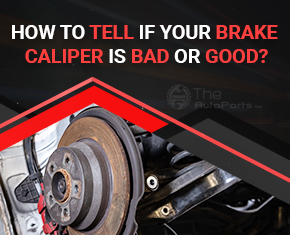Have you noticed that your car seems to pull to one side by itself? Does your brake pedal have a spongy or mushy feeling? These can indicate a faulty brake calliper.
Although brake pads must be changed on a regular basis, callipers ought to last the lifetime of the car, but that isn’t always the case. Callipers may ultimately stop working properly, jeopardising your vehicle’s overall safety.
Knowing the signs of a damaged brake calliper will make it easier for you to take immediate action.
The majority of motorists are aware of the value of sound, well-maintained braking systems. A vehicle’s braking system is crucial for safety. It is crucial to understand the components necessary for a vehicle to stop safely as well as the warning signs of faulty components. The importance of brake callipers to your car’s braking system and warning signals that they could require maintenance or replacement are discussed below.
What is a brake calliper?
Your car’s disc braking system includes the brake callipers. The brake pads and pistons are kept inside the brake calliper. The brake callipers can slow the wheels of the automobile by causing friction with the braking rotors. In essence, the brake calliper on your car is responsible for pressing the brake pad on the rotor to bring it to a halt. The brake calliper serves a crucial purpose, thus it must be maintained and replaced as needed.
How to determine whether your brake calliper is malfunctioning?
Here are some symptoms that you can experience if your brake calliper is malfunctioning. It might be challenging to identify problems with your braking system or with your brake calliper specifically.
1. Warning Light: When the brake or anti-lock braking system (ABS) light on your car illuminates, it is a clear indication that there may be a problem with your braking system.
2. Fluid Leaks: You could see brake fluid around your wheels or in the engine area. Hydraulic fluid is used to actuate brake callipers, as well as the bleeder screw or piston seal might develop leaks.
3. Soft, Spongy Brake Pedal: The brake pedal may feel soft or spongy if your brake calliper is leaking. Additionally, sticky sliders or a seized piston in the calliper may leave extra space between the pad and the rotor, giving the pedal an odd sensation.
4. Reduced Braking Ability: Your car won’t brake as effectively if the brake calliper is broken, which causes the brake pedal to soften. Additionally, you could find yourself repeatedly pumping your brakes to get them to function properly.
5. Dragging Sensation: Additionally, you could feel like you’re dragging when driving. As you drive, the brake pads press up against the rotors, producing this sensation. At all times, the impacted brakes will be partially or fully engaged
6. Noisy Braking: The brake pads on a stuck brake calliper will degrade over time. Your brakes start to grind and screech repeatedly as a result.
7. Jerking or Pulling to One Side: You can experience jerking or pulling to one side when braking. This symptom might indicate that the calliper sliders or brake calliper are seizing. You could experience it when driving, albeit it is most noticeable while driving.
8. Uneven Wear: You could notice that the wear on your brake pads is uneven. The pads will only be partially applied and will drag on the rotor if the calliper, pistons, or slider pins are stuck.
What to do if you believe your brake callipers may be defective?
A broken brake calliper can be fixed in a variety of ways. You might check your brake callipers for leaks, see if the brake pads are wearing abnormally, or examine how the piston in the calliper is working. Another option is to do a line lock test.
Leaving your brakes uncontrolled is something you should avoid doing. If you ignore a stuck or seized brake calliper, it may result in a partial or complete loss of braking power, costly repairs, or threaten your safety while driving. If your car displays any of the aforementioned problems, you should check to see if it has a damaged brake calliper and have it serviced as soon as possible.
A crucial part of the disc braking system is the brake calliper. Any issues with this component might make brakes less effective and endanger your safety. You will be better able to identify the signs of a malfunctioning brake if you are familiar with the brake calliper and how it works.
Never take a chance with your brakes, Period. Partial or total loss of braking capacity might result from a seized or stuck brake calliper. If your car is displaying any of the aforementioned signs and you’re very sure you do have a faulty brake calliper, fix it immediately.
Additionally, you could hear some individuals discuss repairing brake callipers. But replacement callipers are affordable and widely available; hardly one overhauls them these days. It is the twenty-first century. Get a calliper that is fresh or refurbished. It’s a lot simpler.
A professional can replace the calliper for you if you don’t feel up to doing it yourself. You don’t want to take any risks with your brakes, to reiterate.
